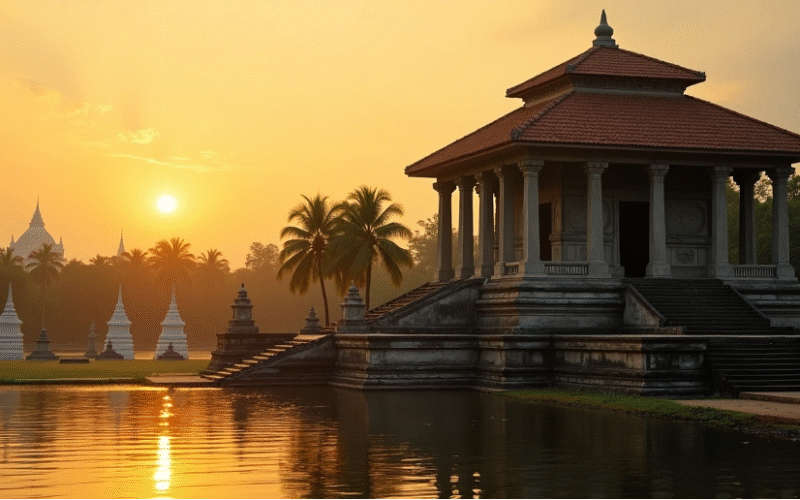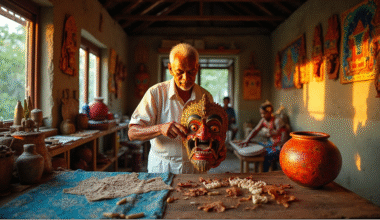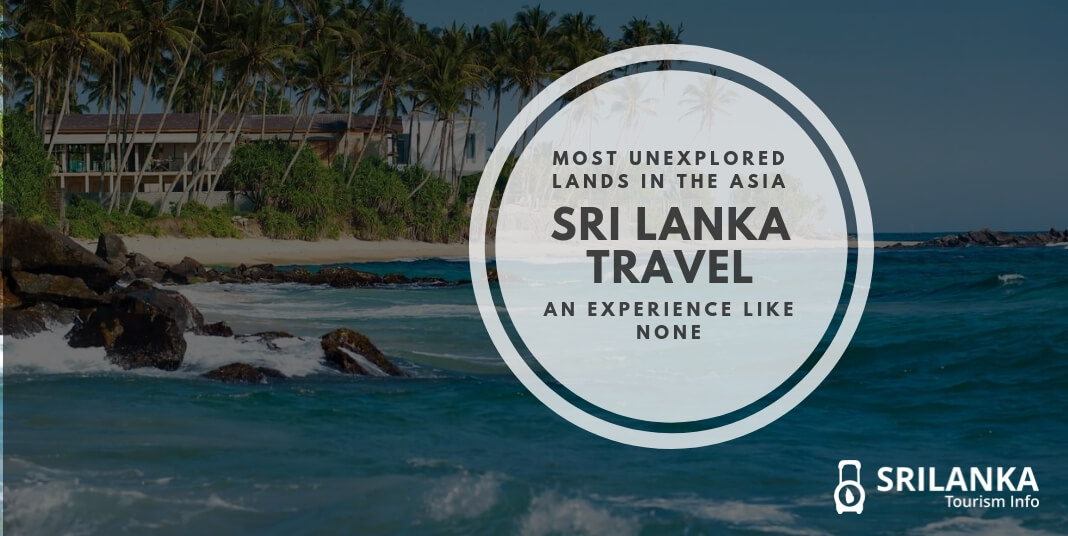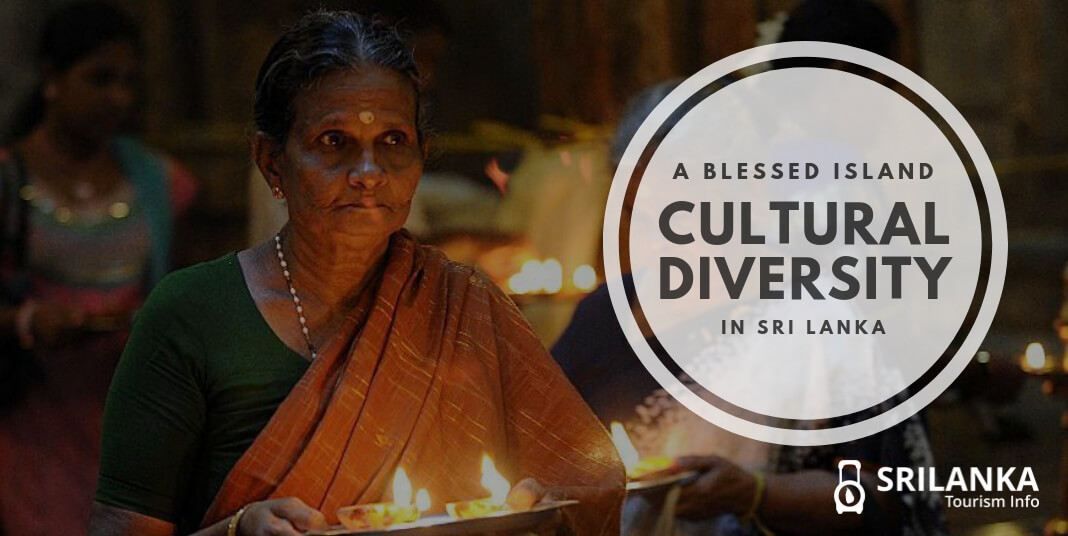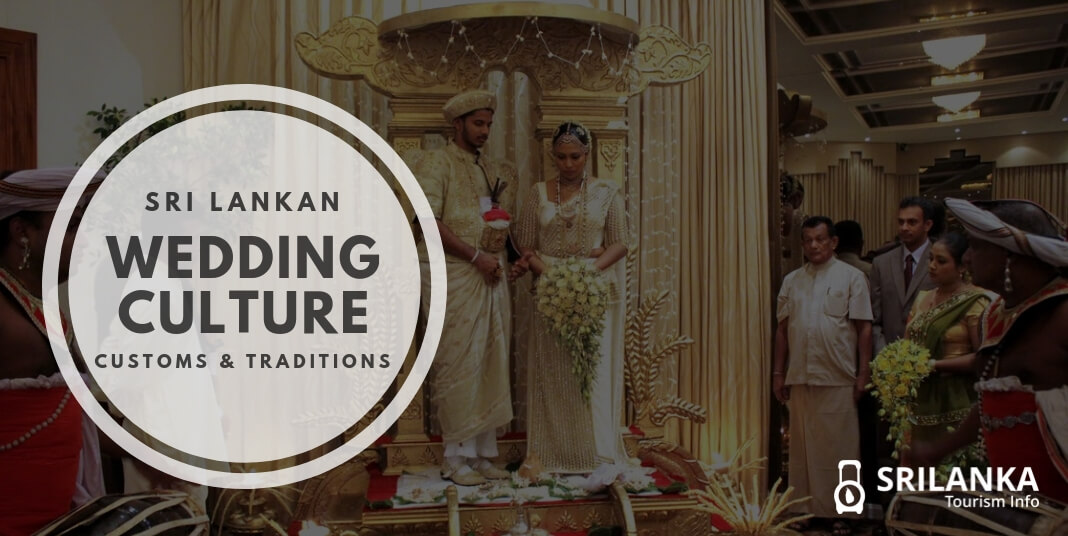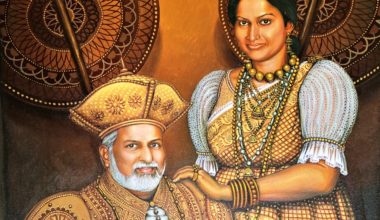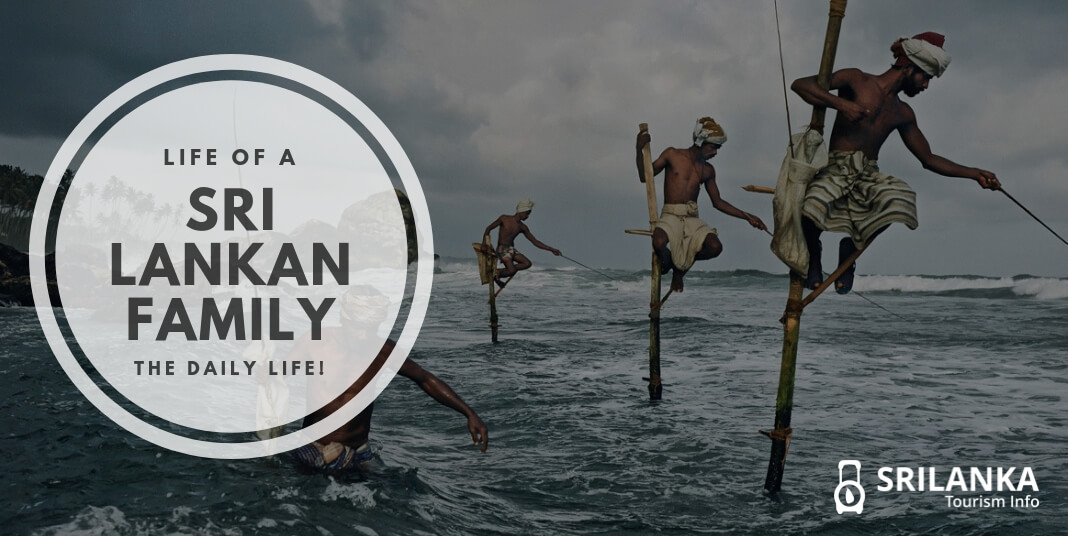Sri Lanka’s monarchy stands as one of the world’s longest-lasting, stretching an incredible 2,358 years from 543 BCE to 1815 CE. The sort of thing I love about this fact is the sheer longevity and these rulers’ effect on culture.
Prince Vijaya’s arrival marked the beginning of Sri Lanka’s rich history with Tambapanni Kingdom’s founding in 543 BCE. The magnificent Anuradhapura Kingdom followed and lasted until 1017 CE. Sri Lankan kings created engineering marvels that amaze us even today. The 5,000-acre Parakrama Samudra reservoir and the architectural wonder of Ruwanwelisaya stupa stand as testament to their brilliance. Buddha’s Tooth Relic became a fascinating symbol of kingship – rulers needed to possess it to legitimize their reign. Sri Lanka’s timeline shows remarkable continuity with human settlements dating back more than two millennia. The earliest urban developments near Anuradhapura appeared in the 10th century BCE.
This piece explores 15 powerful kings who shaped Sri Lanka’s destiny. Their military conquests, religious patronage, and extraordinary architectural achievements continue to engage the world today.

Image Source: YouTube
The recorded history of Sri Lanka begins with Prince Vijaya’s legendary trip to the island. Vijaya became the first monarch in the long line of sri lankan kings. He reached the island around 543-505 BCE, right at the time of Gautama Buddha’s passing. This timing between Buddha’s parinibbana and Vijaya’s arrival holds deep symbolic meaning in sri lankan history.
Prince Vijaya’s historical role
King Sinhabahu’s son Vijaya, whose grandfather was a lion according to legend, lived in the kingdom of Sinhapura in northern India. His father banished him and 700 followers because of their notorious behavior. The king had their heads half-shaved before setting them adrift on ships.
Vijaya met an indigenous Yakkhini named Kuveni after landing in Lanka. Their alliance proved decisive as Kuveni helped him defeat the local Yakkhas. Together they had two children: Jivahatta and Disala. Notwithstanding that, their partnership didn’t last – Vijaya left Kuveni to start a royal lineage by marrying a noble-born princess.
Prince Vijaya’s founding of Tambapanni
The birth of Tambapanni kingdom marks a vital milestone in the sri lanka history timeline. Vijaya’s followers got their hands stained with red soil upon landing, which led to the name “Tambapanni” (copper-colored hands).
Vijaya’s ministers built several settlements on the island:
- Upatissagama on the bank of the Gambhira river
- Anuradhagama
- Uruvela
- Vijita
The Pandyan king of Madhura (modern Madurai) sent his daughter to marry Vijaya. He also provided a hundred noble maidens for Vijaya’s followers, craftsmen, and a thousand families from eighteen guilds. These strategic collaborations strengthened the young kingdom’s diplomatic ties.
Legacy of Prince Vijaya in Sri Lankan history
Sri Lankan identity rests firmly on Vijaya’s legacy. His 38-year reign brought peace and justice through established governance systems. His followers adopted the name “Sinhala” after his father Sinhabahu, which laid the groundwork for Sinhalese identity.
Scientists haven’t found archeological evidence of Vijaya’s arrival, but his story remains the origin tale of the Sinhalese people. The kingdom of Tambapanni grew into one of history’s longest-lasting monarchies that substantially shaped the island’s cultural and political landscape throughout history.
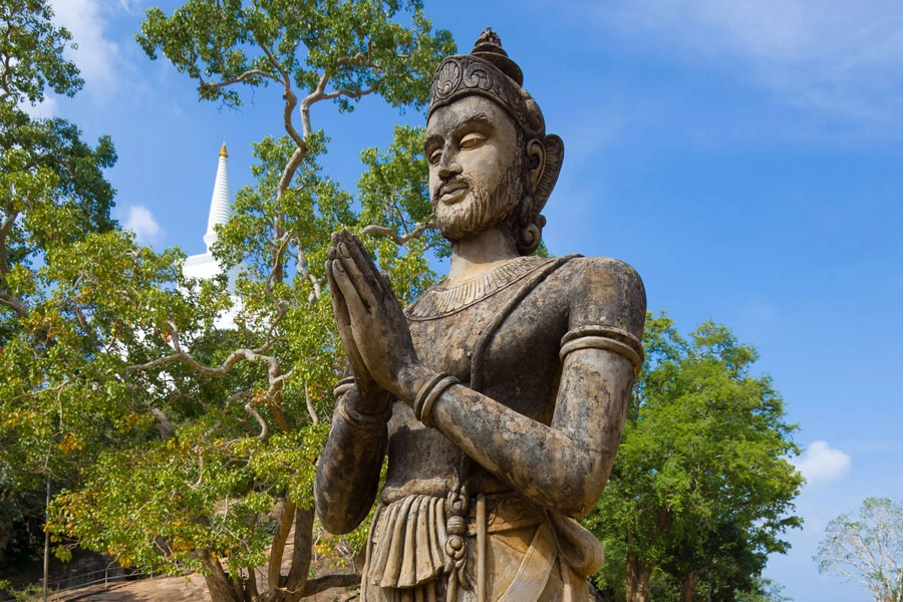
Image Source: Next Travel Sri Lanka
King Devanampiya Tissa’s reign (247-207 BCE) marked a defining moment that altered Sri Lanka’s religious map forever.
Devanampiya Tissa and the arrival of Buddhism
A life-changing encounter between Devanampiya Tissa and Mahinda Thero, Emperor Ashoka’s son (or possibly brother) from India, brought Buddhism to Sri Lanka. Historical chronicles tell us that the king was hunting with 40,000 soldiers near Mihintale mountain when he met Mahinda. The king first thought the monk was a “yakka” (demon), but quickly realized these were missionaries from India.
This famous conversation on Poson Poya day in 247 BCE led the king to embrace Buddhism, making it the state religion. The story took an amazing turn when Sanghamitta, a Buddhist nun, brought a cutting from the sacred Bodhi tree to Sri Lanka. This tree, under which Buddha reached enlightenment, was planted at the Mahavihara. Its descendant still thrives today and stands as Sri Lanka’s most visited pilgrimage site.
Construction of Mahavihara
The king’s newfound faith inspired him to build the Mahavihara (Great Monastery) in Anuradhapura. He gave the royal Mahamegha park to Buddhist monks, and this monastery became Theravada Buddhism’s central institution in Sri Lanka.
The king’s construction projects included:
- Thuparamaya, Sri Lanka’s first historical stupa, which houses Buddha’s right collarbone relic
- Tissa Wewa, a massive 550-acre irrigation tank with an embankment 2 miles long and 25 feet high—still helping Anuradhapura’s farmers today
Cultural impact of Devanampiya Tissa
Devanampiya Tissa’s reign altered Sri Lankan society completely. His blend of state power with Buddhism created a blueprint that all but one of these sri lankan kings followed. He placed temples near his royal palace to maintain control over religious institutions while providing financial support.
Buddhism grew into Sinhalese culture’s highest ethical and philosophical expression. This spiritual revolution sparked new artistic forms and monumental architecture throughout the sri lanka history timeline. Every monastery adopted Bodhi tree worship, with Buddha images facing the four cardinal directions—a unique feature of local Buddhist practice.
Devanampiya Tissa’s actions made him one of the most significant figures in sri lankan history. His religious and cultural foundations still shape the nation’s identity today.
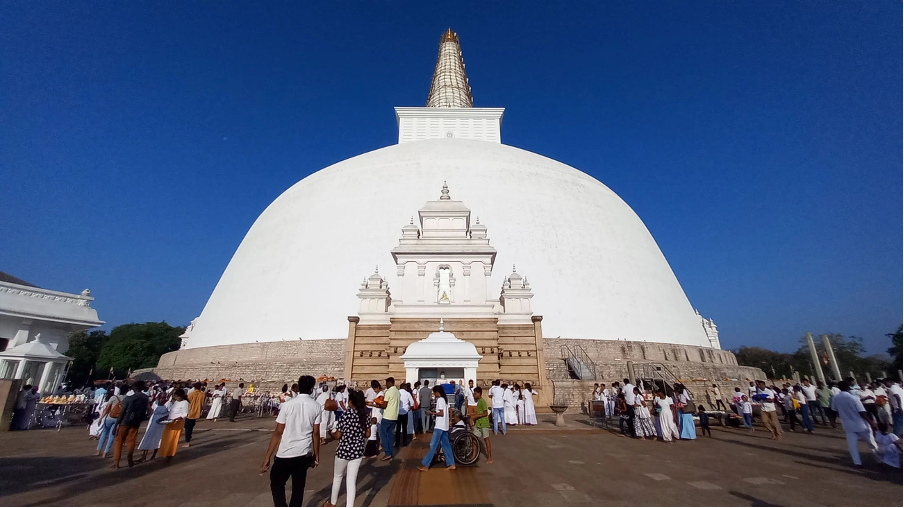
Image Source: AmazingLanka.com
Among the greatest sri lankan kings, Dutugamunu (161-137 BCE) emerged as a legendary warrior who transformed the island’s history. He was born during a time of foreign rule and inherited his father Kavantissa’s vision to reclaim Anuradhapura from the Tamil king Elara.
Dutugamunu’s military campaigns
Dutugamunu proved his military brilliance after securing his throne in a brief conflict with his brother Tissa. His formidable army included chariots, troops, and war elephants, with his loyal elephant Kandula leading the charge. His father had recruited ten remarkable warriors who fought alongside him:
- Nandhimitra, Suranimala, Mahasona, Theraputtabhya, Gotaimbara
- Bharana, Vasabha, Khanjadeva, Velusamanna, and Phussadeva
The campaign against Elara featured strategic sieges and fierce battles. His tactical genius shone during the four-month siege of Vijitanagara, where enemy forces used “red-hot iron and molten pitch” to disrupt his elephant corps. The final battle took place at Anuradhapura’s eastern gate, where Dutugamunu rode Kandula to victory against Elara on his elephant Mahäpabbata.
Ruwanwelisaya stupa construction
Dutugamunu started building the magnificent Ruwanwelisaya (Great Stupa) around 140 BCE after unifying the island. Elephants with leather-bound feet hammered crushed rock into place as the foundation was laid on Vesak’s full moon day. The massive project required thousands of workers who received tasks based on their caste.
The construction faced several setbacks. The flower stages collapsed nine times before finally staying stable on the tenth attempt. Dutugamunu fell ill before seeing his masterpiece completed. His brother Saddhatissa brought comfort to the dying king by showing him a cloth model of the stupa’s top portion.
Dutugamunu’s role in unifying Sri Lanka
Dutugamunu’s triumph over Elara gave him control over almost the entire island. He defeated 32 Tamil kings during his campaign and achieved Sri Lanka’s first complete unification. The victorious king showed exceptional respect to his fallen opponent by building Elara’s tomb and ordering all passersby to dismount and pay their respects.
Sri Lanka gained territorial and cultural unity under his rule. Before his reign, Elara’s Tamil followers had reportedly troubled Buddhists. Dutugamunu created a lasting legacy for future kings of sri lanka by combining political leadership with Buddhist devotion, establishing between 68 and 99 religious sites.
Valagamba (Vattagamani Abhaya)
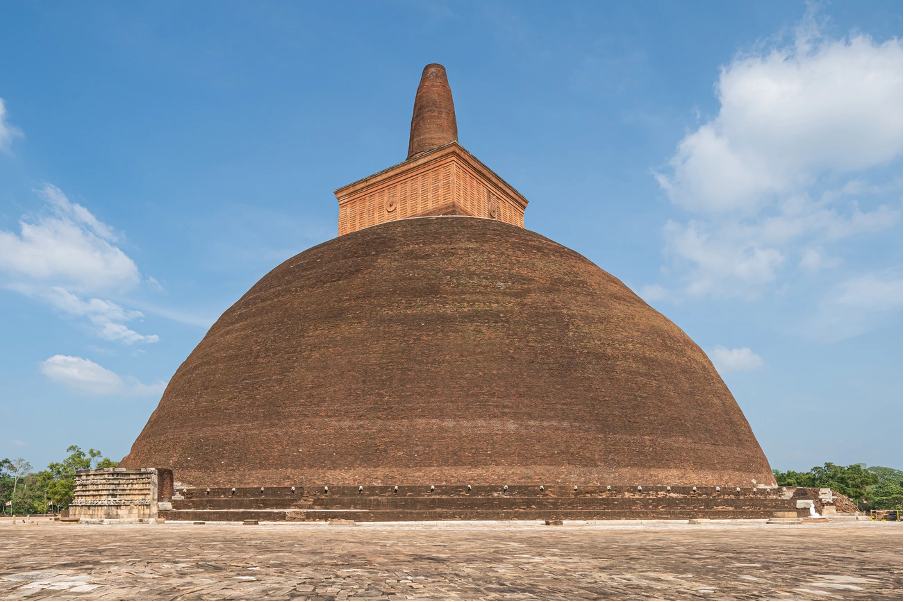
Image Source: Wikipedia
King Valagamba’s extraordinary tale of exile and triumph stands out as one of the most dramatic chapters in sri lankan history. This resilient monarch experienced something his predecessors never did – losing his throne before making a powerful comeback that would reshape the island’s religious scene.
Valagamba’s return to power
Rebels overthrew Valagamba in 89 BCE and forced him into a long exile. He spent fourteen years wandering through the wilderness and found shelter in caves that later became the Dambulla Rock Temple. Local legends tell of a deity who appeared as a stag and guided the lost former king to Adam’s Peak. There, he gathered the forces needed to reclaim his kingdom.
Valagamba defeated Dathiya, the last Tamil leader among the invaders, and took back his throne around 89 BCE. His queen Somadevi returned to her rightful position by his side. The king ruled for twelve more years until his death in 77 BCE.
Construction of Abhayagiri Vihara
The king’s most important achievement during his second reign was building the Abhayagiri Vihara. The name combines the king’s own name (Abhaya) with Giri, a Jain monk who lived at the site before. This spectacular complex featured the Abhayagiri Dagaba, which rose to an impressive height of about 70 meters (230 feet).
The king hosted grand celebrations after completing this massive project. He then presented the temple to Reverend Maha-Tissa. From that point on, this establishment received royal support among other existing temples like Mahavihara.
Religious patronage under Valagamba
The king turned the cave shelters that protected him during exile into the famous Dambulla Rock Temple. He decorated these caves with statues and detailed carvings. He also built Somarama (or Somawati) temple as a tribute to his queen.
His reign saw the first split in Sri Lankan Buddhism when 500 monks left Mahavihara to join Abhayagiri and formed a separate sect. Yet during this time of division, a unifying milestone occurred – Buddhist monks wrote down the Tripitaka (Buddhist scriptures) for the first time at Aluviharaya temple in Matale.
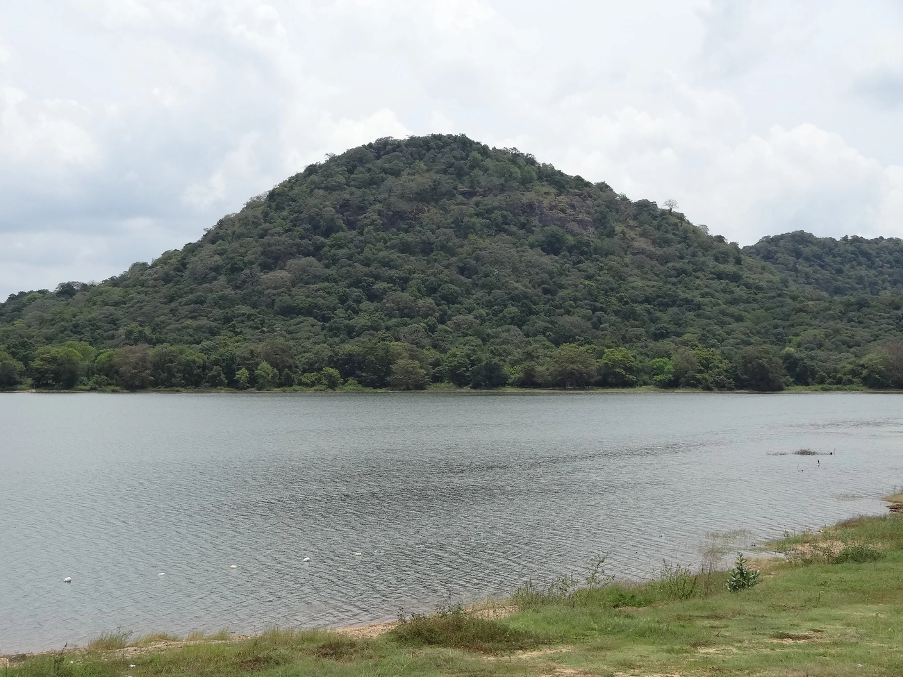
Image Source: Wikipedia
Mahasena (276-303 CE) ranks among the most ambitious sri lankan kings who knew how to master irrigation engineering. His monumental water management systems changed the landscape and still function today.
Mahasena’s irrigation projects
During his 27-year reign, Mahasena proved himself as maybe the greatest reservoir builder of ancient Sri Lanka. The Mahavamsa chronicle documents that he built sixteen major irrigation reservoirs and two most important canals. British Governor Henry Ward praised his engineering achievements: “No wisdom and no power in the ruler can have forced such efforts even upon the most passive oriental nations, without general persuasion that the work was one of paramount necessity”.
His notable achievements included:
- Padaviya (Rattamalakandaka) reservoir
- Nachchaduwa (Mahadaragala) reservoir with a 5,550-foot embankment
- Tissavaddhamanaka (identified as modern Kawudulla tank)
- Elahara canal completion, which King Vasabha started
Construction of Minneriya Tank
The magnificent Minneriya tank stood as the crown jewel of Mahasena’s hydraulic projects. This massive reservoir spread across 4,670 acres with a 21-mile circumference. The bund reached 44-50 feet high and stretched 1.25 miles long.
The tank managed to keep its water supply throughout the year through the Elahara canal that channeled water from both Mahavali and Amban rivers. The project showed such remarkable engineering skill that future generations believed demons, not humans, built it.
Religious reforms and controversies
Among his irrigation achievements, Mahasena supported heterodox Buddhist sects, which created major religious tensions. He persecuted the orthodox Mahavihara monastery under monk Sanghamitta’s influence and destroyed its buildings.
The death of Sanghamitta and strong public opposition made Mahasena change his stance. He rebuilt the Mahavihara and created a new temple called Jetavana on its grounds. His successful irrigation works improved agriculture across the country, which reduced people’s opposition toward him.
His extraordinary irrigation systems remain his lasting legacy. These systems still benefit Sri Lankan farmers after nearly two millennia – evidence of his engineering vision and the durability of ancient sri lankan water management techniques.
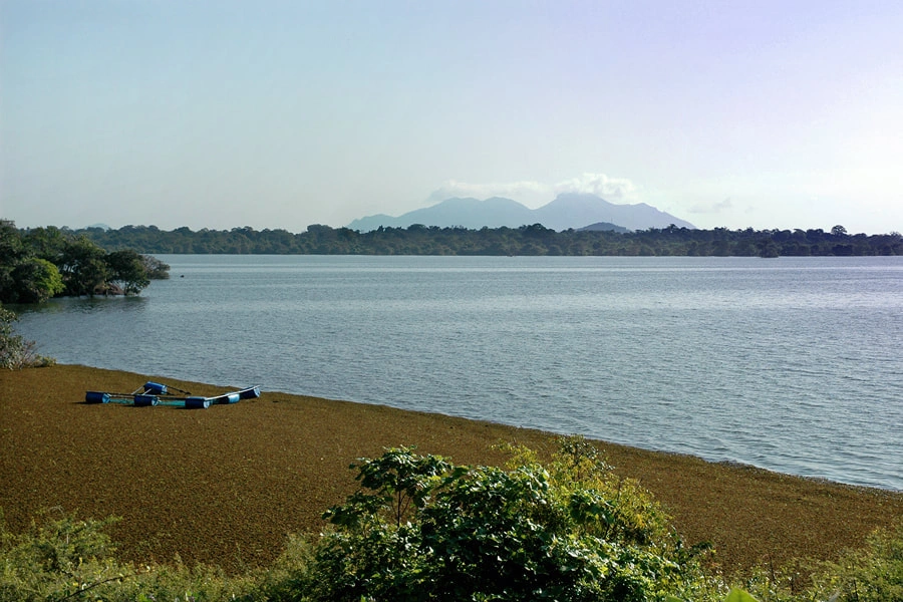
Image Source: lanka excursions holidays
King Dhatusena (455-473 CE) liberated Sri Lanka from Dravidian invaders after 26 years of foreign control. He became one of the most significant kings of sri lanka throughout the island’s history.
Dhatusena’s restoration of Anuradhapura
Buddhist monk Mahanama (author of the Mahavamsa) raised his nephew Dhatusena, who spent his early years in hiding as an ordained monk to avoid detection. He gathered an army and led an intense 18-year campaign against the Chola dynasty. The final ruler, Pithiya, fell to his forces in 459 CE. Once he reclaimed the throne, he began restoring Anuradhapura’s former glory.
The capital’s rebuilding included many more religious monuments, with 18 viharas (temple complexes). His restoration work transformed the Abhayagiri temple, rebuilt Monara Pirivena, fixed broken stupa canopies, and renovated the Brazen Palace. He hosted a special procession to honor Buddhism’s roots in sri lankan history that celebrated Arhant Mahinda, as with King Devanampiyatissa’s celebrations from centuries past.
Kala Wewa reservoir
The king’s greatest gift to sri lanka history timeline showed in his remarkable hydrological engineering. He built 18 massive tanks and an equal number of smaller reservoirs. Kala Wewa stood as his masterpiece – an engineering marvel spanning 60 kilometers (37 miles) in circumference and covering 18 square kilometers (7 square miles). This vast reservoir collected water from both monsoons to ensure year-round supply.
The Yoda Ela (Jaya Ganga) canal proved even more remarkable – a 54-mile channel that descended just 95 millimeters per kilometer with incredible precision. Water flowed from Kala Wewa through this canal to Anuradhapura’s tanks, doubling the capital’s water supply. The sort of thing i love about this fact about sri lanka comes from the king’s response about his treasures – he simply pointed to Kala Wewa, saying it was his only wealth.
Dhatusena’s tragic end
This answer sealed the king’s fate. His son Kassapa, born to a concubine, wanted his father’s treasures. The prince flew into a rage at the king’s answer about the reservoir being his only wealth and ordered his execution. Dhatusena met a horrific end – stripped naked, bound in chains, and buried alive in Kala Wewa’s bund, the very structure he had built. His 18-year reign ended brutally, but it sparked another fascinating chapter in sri lankan history as Kassapa went on to create the magnificent Sigiriya rock fortress.
The majestic Sigiriya rock fortress shows evidence of both genius and infamy in the sri lankan history timeline. King Kashyapa I (477-495 CE) built this fortress after he violently seized power.
Kashyapa I and Sigiriya
Kashyapa seized the throne through patricide and left the traditional capital of Anuradhapura. He moved deep into central Sri Lanka’s forests. His brother Moggallana had escaped to India, and Kashyapa feared revenge. He chose a striking black rock rising 600 feet above the surrounding plains as his sanctuary.
Buddhist mythology inspired Kashyapa’s vision—specifically the mythical city of Alakamanda. This heavenly realm belonged to Kuvera, the god of wealth and plenty. The 13th-century Culavamsa chronicle notes that he “built there a fine palace, worthy to behold, like another Alakamanda and dwelt there like (the god) Kuvera”.
Sigiriya as a rock fortress and palace
The fortress design merged military defense with beauty. Kashyapa added ramparts and moats to protect the area. He changed a Buddhist monastery into a royal citadel that featured water gardens, ponds, and fountains.
A palace sat at the summit, and visitors had to climb through several architectural zones to reach it. Kashyapa’s most impressive creation was the Lion Staircase. This massive gatehouse and staircase took the shape of a lion. The final climb to the summit began through the lion’s chest. This feature gave the fortress its name “Sihagiri” or Lion Rock.
Art and architecture of Sigiriya
Kashyapa’s vision led him to paint the entire rock white to make it look like a cloud floating above the trees. The western rock face held the stunning Sigiriya frescoes. These originally included over 500 paintings of lightly-clad females, thought to be celestial beings. Today, only 21 of these beautiful paintings remain.
The Mirror Wall stands as another remarkable feature. This highly polished parapet followed the rock face with such shine that visitors could see their reflection. The water gardens showed expert hydraulic engineering skills. The fountains in these gardens still work today.
Kashyapa’s reign ended up as dramatic as it began. His brother defeated him in battle in 495 CE, and he took his own life. His architectural legacy lives on as one of the most remarkable achievements among all sri lankan kings.
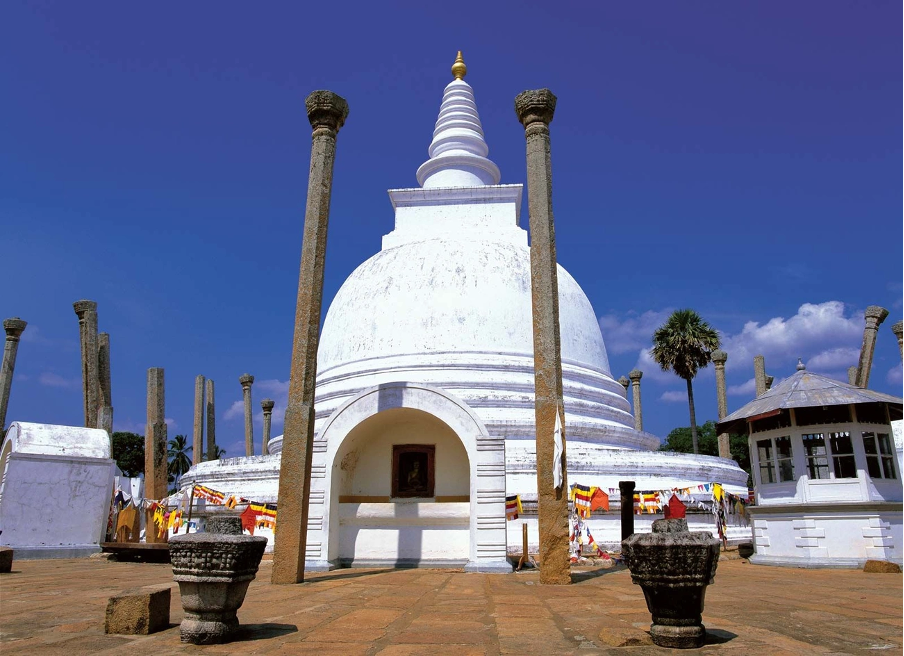
Image Source: Britannica
A pivotal change occurred in Sri Lankan politics during the seventh century when Manavamma (684-718 CE) rose to power with foreign help, which marked a new chapter in the island’s royal lineage.
Manavamma’s alliance with Pallavas
King Kassapa II’s death around 650 CE forced Manavamma to flee to South India instead of getting involved in dangerous succession conflicts. His exile turned fortunate as he developed a friendship with Narasimhavarman I, the powerful Pallava ruler. Manavamma’s military prowess showed when he helped the Pallavas win their war against the Chalukyas, securing a decisive victory at the Battle of Vatapi.
Narasimhavarman showed his gratitude by providing Manavamma with a formidable armed force to reclaim Sri Lanka’s throne from King Dathopatissa II. His first attempt failed, but Manavamma stayed determined. He served in the Pallava court for nearly two decades until another chance arose. With support from Narasimhavarman II, Manavamma finally defeated his rivals and claimed power in 684 CE.
Rebuilding Anuradhapura
The new king faced an immense challenge of restoring a kingdom broken by political turmoil. Manavamma quickly started rebuilding Anuradhapura’s neglected infrastructure. He focused on economic recovery, fixed irrigation systems, and rebuilt damaged structures across the country.
Stabilizing the kingdom
Manavamma’s greatest achievement was ending almost 50 years of civil strife that had devastated the nation. He removed Tamil officials from high positions and watched their work closely, which reduced their political influence. His rule saw Tamil ministers and generals, who had previously dominated Sri Lankan politics, fade from power.
The second Lambakanna dynasty, founded by Manavamma, created a lineage that would rule Anuradhapura for roughly 400 years. This dynasty produced many distinguished kings who combined and expanded Sinhalese political power. His reign brought a golden era that lasted about four centuries.
Manavamma’s time in the Pallava kingdom left a lasting mark on Sri Lankan culture. The Pallava school’s artistic influence shaped Sinhalese architecture and sculpture, introducing Hindu motifs that became part of the island’s artistic traditions.
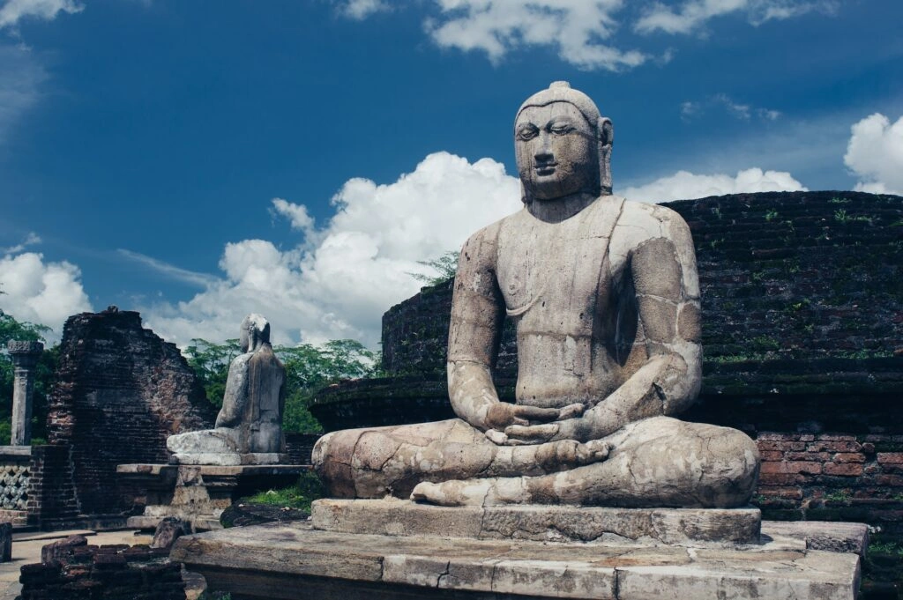
Image Source: Tranquil Tours
Vijayabahu I (1055-1110 CE) emerged as a determined liberator who reclaimed Sri Lanka’s sovereignty after decades of Chola rule that started in 993 CE. His remarkable persistence would change the nation’s destiny.
Vijayabahu I’s defeat of Cholas
The liberation campaign lasted an incredible seventeen years. Vijayabahu made the best of his strategic advantages even without a unified national force. He knew a long war would favor the Sinhalese more than the Cholas. His chance came when Chalukyas attacked the Chola Empire in their homeland, which drew their attention away from Sri Lanka.
Vijayabahu captured Polonnaruwa briefly in his first attack in 1066, but Chola reinforcements pushed him back. He stayed determined and continued his resistance from several strongholds. Civil war broke out in the Chola Empire by 1070, and Vijayabahu launched a brilliant three-pronged attack:
- One army moved along the western shore toward Mahatittha and Polonnaruwa
- Another came from the east across Magama
- His main force advanced through Mahiyanga
His forces entered Polonnaruwa in 1070 after a seven-month siege, which ended 77 years of foreign control.
Restoration of Buddhist institutions
Buddhism had suffered greatly under Chola rule that favored Saivite Hinduism. The religious landscape lay in ruins when Vijayabahu took power. He couldn’t find even five ordained monks—needed for upasampada (ordination)—anywhere in the country.
King Anawrahta of Burma sent ordained monks to help revive Sri Lanka’s Buddhist traditions after Vijayabahu asked for help. Under his support:
- Workers repaired many abandoned and destroyed temples
- A new temple rose in Polonnaruwa for the sacred tooth relic
- Thousands of monks received ordination
Polonnaruwa as new capital
Vijayabahu made a strategic choice to declare Polonnaruwa (renamed “Vijayaraja pura”) his capital instead of the traditional Anuradhapura. The eastern location offered several benefits:
- Better defense against south Indian invasions
- Better control over the route to Ruhuna
- A central spot to manage the entire kingdom easily
Polonnaruwa served as the capital for about 150 years. The city built strong trade connections with China through the port of Gokanna (Trincomalee).
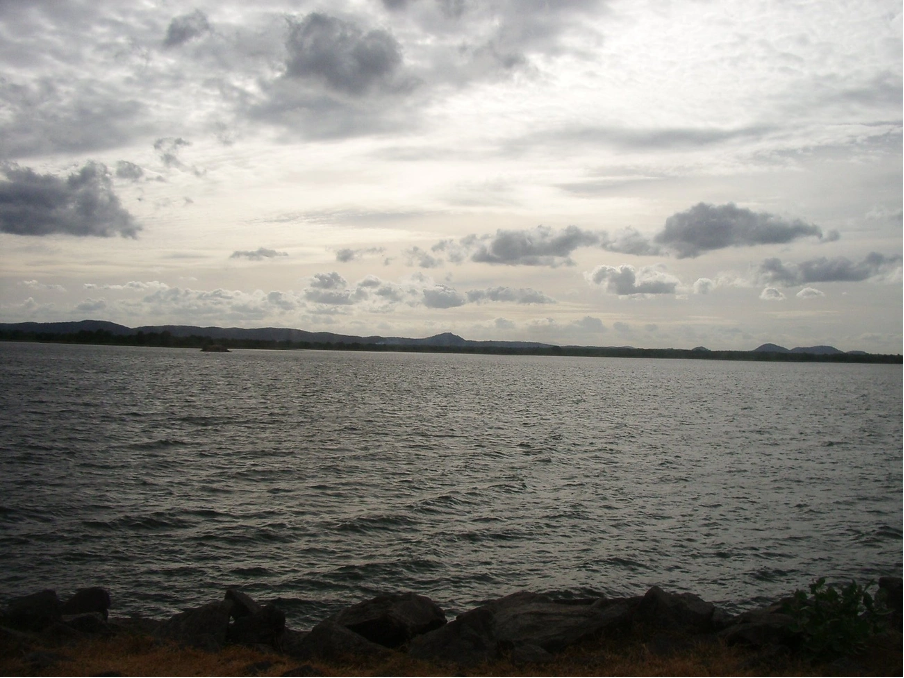
Image Source: Wikipedia
The 12th century marked a golden era in the sri lanka history timeline when King Parakramabahu I (1153-1186 CE) turned Polonnaruwa into an architectural marvel that rivaled ancient Rome.
Parakramabahu I’s reign and reforms
King Parakramabahu, son of Manabharana, brought unity to Sri Lanka after long civil wars. He created a sophisticated government with 12 provincial governors, princes, army generals, and merchants. His influence reached beyond borders through trade relations with China, Angkor, and Middle Eastern countries. He launched military campaigns against Burma and supported the Pandyan dynasty in their fight against Chola rivals.
The king made sweeping religious changes in 1165. He purified Buddhist practices by removing lax monks but allowed Hindus to worship freely. He also banned advanced practices and books of Mahayana Buddhism, which altered the map of Sri Lankan religion for centuries.
Parakrama Samudra reservoir
The king’s greatest achievement stands as the massive Parakrama Samudra—an engineering wonder of five connected reservoirs. This huge irrigation system, known as the “Sea of Parakrama,” holds 116,000 acre-feet of water and waters about 25,000 acres of paddy fields.
The king showed his commitment through his famous words: “do not let even a drop of rainwater in this country go to the sea without use”. The reservoir’s earthen embankment stretches over 8.5 miles and rises more than 100 feet high. It contains about 4.5 million cubic yards of earthwork. This project was so huge that 1,000 men would have worked non-stop for 12 years to finish it.
Architectural and religious legacy
Parakramabahu’s building projects went way beyond irrigation. Under his rule, Polonnaruwa flourished with:
- The Sacred Quadrangle housing Buddha’s tooth relic and alms bowl
- Gal Vihara with its magnificent rock-cut Buddha statues
- Lankatilaka, Tivanka, and Thubarama temples
- Extensive gardens including the “Island Garden” extending into Thupa Wewa
The king strengthened Polonnaruwa’s defenses by building elaborate walls with fourteen gates and archer turrets. He also built hospitals that he visited personally. His wars and building projects ended up emptying the kingdom’s treasury, forcing high taxation rates. Yet this was the price for his unmatched vision that still amazes visitors today.
Image Source: Alamy
King Nissanka Malla (1187-1196 CE) rose to power after Parakramabahu I’s ambitious reign. He claimed to foresee his right to rule. This Kalinga-born king left his mark on the sri lanka history timeline through extensive building works and political declarations.
Nissanka Malla’s inscriptions and temples
Recording achievements became Nissanka Malla’s passion. He ordered stone inscriptions across Polonnaruwa that called him “Fountain of renown,” “Protector of the Earth,” and “Lamp by which the whole world was illuminated”. These inscriptions had political motives. One inscription firmly stated that “non-Buddhists should not be placed in power in Sri Lanka to which the Kalinga dynasty was the rightful heir”.
The king built three major religious complexes. These included Rankoth Vihara (a massive stupa), Hatadage shrine, and renovations of existing temples. The Dambulla cave temple received special attention. His inscription claims he spent 7 lakhs (700,000 units of currency), though another inscription mentions only 1 lakh.
Royal palace and Nissanka Latha Mandapaya
The king’s palace stood near Polonnaruwa’s man-made lake. It featured a royal bathing pool and Council Chamber where ministers’ names were carved into supporting pillars. Historians believe the palace had two stories with a wooden upper floor.
The Nissanka Latha Mandapaya stands as his architectural masterpiece. This unique pillared pavilion features eight granite columns carved like lotus stems with blossoming lotus buds on top. Monks used this distinctive structure to chant Buddhist scriptures for the king.
Promotion of Theravada Buddhism
The king’s most important decree stated that “only a Buddhist had the right to rule the country.” This move secured his position and established religious qualifications for kingship. He showed his devotion by gilding 50 Buddha statues at Dambulla temple and coating the temple’s interior with gold. These actions earned it the name “Swarnagiri” (golden rock).
The king’s religious influence reached beyond borders. An inscription tells us he gave gifts to Cambodians and told them not to kill birds. This shows how he spread Buddhist principles of non-violence internationally.
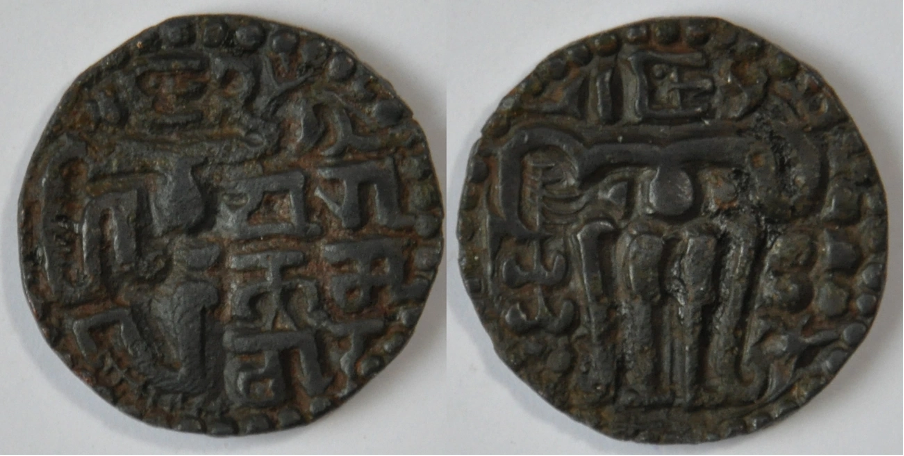
Image Source: Wikipedia
Parakramabahu II (1236-1270 CE) earned the title “Scholar King” and ruled from Dambadeniya. His reign marked a crucial time in sri lankan history as he focused on cultural revival rather than military conquests.
Parakramabahu II’s literary patronage
The king stood apart from other sri lankan kings because we valued intellectual pursuits above all. He earned the prestigious title “Kalikala Sahitya Sarvagna Pandita” (Universal Scholar of Literature). This learned ruler created several works of his own. These included a Sinhala translation of “Visuddhi Magga,” “Vinaya Vinniscaya,” “Dalada Siritta,” and the classic poem “Kawsilumina”.
His court became a center of literary excellence. The works produced under his guidance included:
- “Buthsarana,” “Daham Sarana,” and “Sanga Sarana” by Vidya Chakravarti
- “Pujavaliya” by Buddhaputra
- “Sinhala Sanda Lakuna” (first Sinhala grammar) by Vedeha Thera
- “Saddharmaratanavaliya” by Dharmasena Thera
Temple constructions in Dambadeniya
The king built a three-storied Temple of the Tooth right after his coronation to house Buddha’s sacred tooth relic. King Sri Wikrama Rajasinhe later modified it into a two-storied building during his reign (1798-1815), which showed the king’s devotion.
After placing the tooth relic, he made a public promise to drive out Kalinga Magha, the cruel invader who had destroyed Buddhist institutions. The king also constructed a monastery at Devinuwara. People called it Nandana because it brought them joy.
Cultural revival under his rule
The king’s 33-year reign reversed the cultural and religious decline that foreign invasions had caused. His government fully supported literary works, which started what historians call a golden age of Sinhalese literature.
This period marked a shift where Pāli poetry became part of a growing cosmopolitan literary culture. The cultural rebirth included ongoing Sanskrit studies and Tamil works that Sinhalese kings sometimes funded.
The king’s early village life shaped his deep love for Sinhalese culture. He ended up stepping down in favor of his son Vijayabahu IV in 1269 and passed away about a year later.
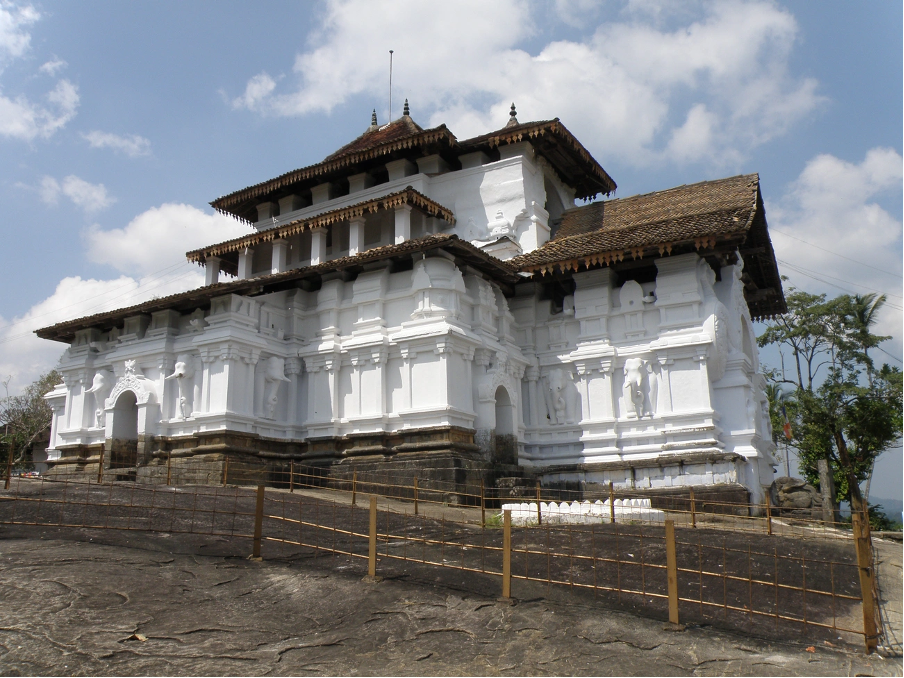
Image Source: Wikipedia
Bhuvanaikabahu IV became a vital architectural patron in the 14th century. His magnificent temples created a legacy that remains central to sri lankan history today.
Bhuvanaikabahu IV and Gampola
Bhuvanaikabahu IV ascended to the throne in 1341 after his father Vijayabahu V of Dambadeniya. He became the first ruler of the Gampola kingdom and changed the capital from Kurunegala to Gampola (Gangasiripura). His General Senalankadhikara provided substantial support during this transition. The nine-year reign lasted until 1353/54 and marked a vital shift in the sri lanka history timeline as power moved to the central highlands.
Lankatilaka and Gadaladeniya temples
Bhuvanaikabahu IV’s legacy lives on through two magnificent religious monuments. The king ordered construction of the Lankatilaka Vihara in 1341 and his Chief Minister Senalankadhikara oversaw the project. South Indian architect Sathapati Rayar designed this temple on Panhalgala Rock, which offers panoramic views of surrounding landscapes. The temple started as a four-storied mansion reaching 80 feet high, though only three stories remain visible now.
The Gadaladeniya Vihara, built in 1344, came to life under Buddhist monk Ven. Seelavamsa Dharmakirti’s supervision. South Indian architect Ganesvarachari designed this impressive structure. The main shrine features a seated Buddha under a Makara Torana (mythical sea-monster arch).
Architectural style of the Gampola period
The 69-year-old Gampola era (1341-1410) created its own architectural identity. Unique door entrance designs found in temples like Gadaladeniya, Lankatilaka, and Niyamgampaya define this period. These temples showcase a remarkable fusion of cultural influences. They blend Sinhalese elements from the Polonnaruwa era with Dravidian and Indo-Chinese architectural patterns.
The structures’ multicultural nature stands out clearly. Lankatilaka temple’s walls bear both Sinhala and Tamil inscriptions. Historians call it Sri Lanka’s longest Tamil inscription. This bilingual approach reveals that pre-colonial kings of sri lanka used Tamil alongside Sinhala officially. Such cultural integration surpassed many other periods in the island’s history.
Also Read: A Walk down the Sri Lankan Wedding Culture, Customs & Traditions
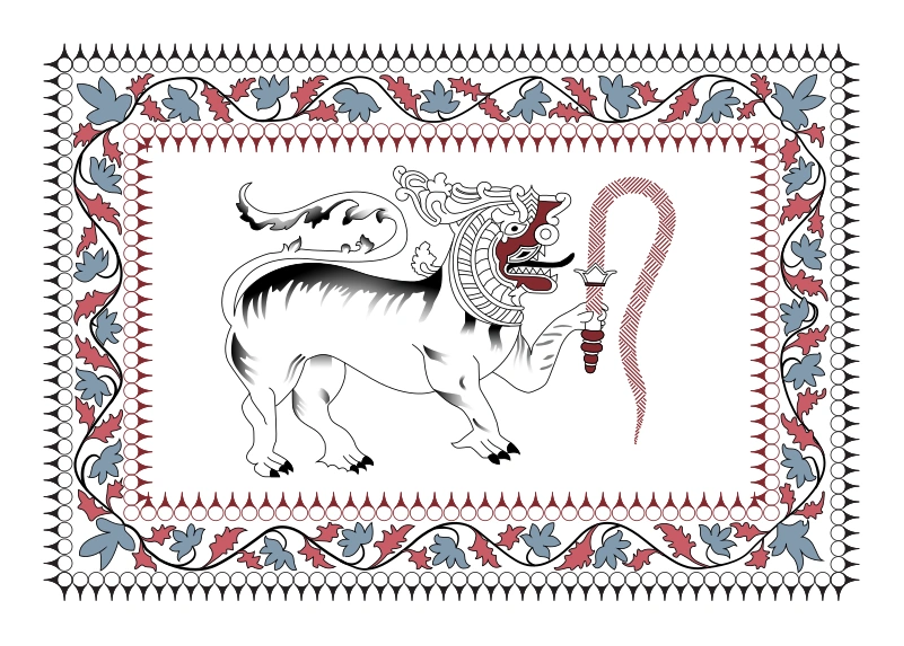
Image Source: Simple Wikipedia
King Parakramabahu VI (1412-1467) became the first ruler since the 12th century to unite Sri Lanka under one sovereign power. His remarkable 55-year reign brought back the island’s glory through political strategy, cultural patronage, and military might.
Parakramabahu VI and Kotte
Parakramabahu made Kotte his capital around 1415, after a three-year rule from Rayigama. This smart move took advantage of the location’s natural defenses, as water and marshlands surrounded Kotte. His connection with Ming China played a key role in his rise—Chinese records show that Admiral Zheng He helped him become king by removing the previous ruler, Alakeshvara. Parakramabahu managed to keep strong diplomatic ties with China and sent at least five missions to show his commitment against sea piracy.
Construction of temples and fortifications
The king built impressive religious and defensive structures across his realm. His three-storied Temple of the Tooth (Dalada Maligawa) protected Buddha’s sacred tooth relic in a golden casket wrapped in a gem-studded container. Laterite stones formed the inner city ramparts that changed Kotte into an almost unconquerable fortress. His support for education led to several prestigious Buddhist institutions:
- Vijayaba Pirivena at Thotagamuwa
- Vanarathana Pirivena at Keeragala
- Sunethradevi Pirivena at Pepiliyana
Last king to unify Sri Lanka
By 1450, Parakramabahu conquered the Kingdom of Jaffna in northern Ceylon, bringing the whole island under his rule. His naval power reached beyond Sri Lanka’s shores—when pirates captured a merchant vessel at Adivirarama Port, he launched a counter-attack that forced five Chola territories to pay him tributes for five years. Sri Lanka saw a cultural renaissance during his reign, with thriving literature and religious revival. His era marked the golden age of Sinhala poetry, especially “Sandesha Poetry”. The unified kingdom ended up falling apart shortly after his death, making Parakramabahu VI the last native ruler to successfully unite all of Ceylon.
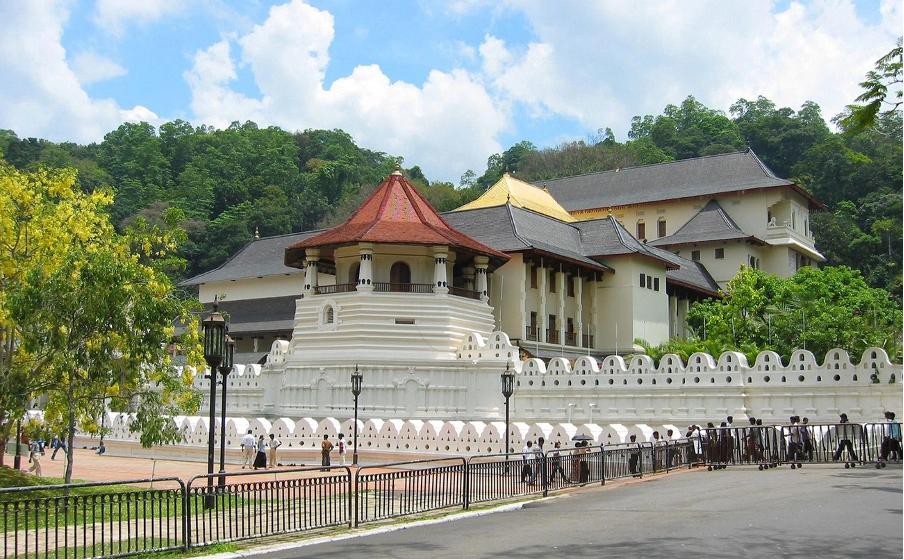
Image Source: Britannica
The 16th century saw Sri Lanka’s Buddhist traditions under threat from Portuguese colonizers. A remarkable leader, Vimaladharmasuriya I (1590-1604), stepped forward to protect both national sovereignty and religious heritage. He started life with a Portuguese baptismal name, Don João da Austria, but later embraced Buddhism and became its champion.
Vimaladharmasuriya I and the Temple of the Tooth
Vimaladharmasuriya understood Buddha’s sacred tooth relic’s political significance deeply. He built a two-story structure next to his royal palace in Kandy to house this precious relic in 1603. The relic had remained hidden at Delgamuwa Vihara in Ratnapura, cleverly concealed inside a grinding stone during Dharmapala of Kotte’s reign. The king’s choice to bring the tooth relic to Kandy made his capital sacred and created a new spiritual haven for Sinhalese Buddhists who faced Portuguese threats.
Resistance against Portuguese
Vimaladharmasuriya’s military genius showed in two decisive victories against Portuguese forces. He crushed a 20,000-strong Portuguese army led by Pedro Lopes de Sousa at the Battle of Danture in 1594. His forces dealt another crushing blow to the invaders at the Battle of Balana in 1602. The king’s brilliant guerrilla warfare tactics used dense forests and mountainous terrain while he thought over direct battles with larger forces. His strategy to cut enemy supply lines worked perfectly, and Portuguese troops had to withdraw after occupying Kandy for three months.
Revival of Buddhism in Kandy
The king found almost no ordained Buddhist monks on the island after his coronation. He sent a minister to Lower Burma to bring back proper ordination. His efforts to refresh Buddhism went beyond the Temple of the Tooth. He restored many ruined Buddhist temples across his kingdom, including Gadaladeniya, Lankathilaka, and Ridi Viharaya. His religious policies showed remarkable tolerance – he never forced his queen Dona Catherina to give up her Catholic faith and let all subjects practice their religion freely.
History remembers Vimaladharmasuriya as the second founder of the Kandyan Kingdom. He created a stronghold of Sinhalese Buddhism that ended up resisting European control for more than two centuries.
Comparison Table
| King | Reign Period | Capital City | Major Constructions/Projects | Notable Military Achievements | Religious Contributions |
| Prince Vijaya | 543-505 BCE | Tambapanni | Key settlements: Upatissagama, Anuradhagama, Uruvela, Vijita | Won against Yakkhas with Kuveni’s support | Created first governance systems |
| Devanampiya Tissa | 247-207 BCE | Anuradhapura | Thuparamaya stupa, Tissa Wewa reservoir | Not mentioned | Made Buddhism the state religion, built Mahavihara |
| Dutugamunu | 161-137 BCE | Anuradhapura | Ruwanwelisaya stupa | United Sri Lanka after defeating Tamil king Elara | Built 68-99 religious sites |
| Valagamba | 89-77 BCE | Anuradhapura | Abhayagiri Vihara, Dambulla Rock Temple | Reclaimed throne after 14 years in exile by defeating Dathiya | Started first Buddhist schism |
| Mahasena | 276-303 CE | Anuradhapura | 16 major irrigation reservoirs, Minneriya tank | Not mentioned | Built Jetavana temple |
| Dhatusena | 455-473 CE | Anuradhapura | Kala Wewa reservoir, Yoda Ela canal | Ended Chola dynasty’s rule | Built 18 viharas |
| Kashyapa I | 477-495 CE | Sigiriya | Sigiriya rock fortress, water gardens | Not mentioned | Changed Buddhist monastery into royal citadel |
| Manavamma | 684-718 CE | Anuradhapura | Restored damaged infrastructure | Won against rivals with Pallava help | Removed Tamil officials |
| Vijayabahu I | 1055-1110 CE | Polonnaruwa | Built new temple for tooth relic | Defeated Cholas in 17-year campaign | Restored Buddhist ordination with Burma’s help |
| Parakramabahu I | 1153-1186 CE | Polonnaruwa | Parakrama Samudra reservoir, Sacred Quadrangle | Led campaigns against Burma, helped Pandyans | Reformed Buddhist practices |
| Nissanka Malla | 1187-1196 CE | Polonnaruwa | Rankoth Vihara, Nissanka Latha Mandapaya | Not mentioned | Added gold to 50 Buddha statues at Dambulla |
| Parakramabahu II | 1236-1270 CE | Dambadeniya | Temple of the Tooth | Vowed to remove Kalinga Magha | Supported Buddhist literature |
| Bhuvanaikabahu IV | 1341-1353/54 | Gampola | Lankatilaka and Gadaladeniya temples | Not mentioned | Combined Buddhist-Hindu architectural styles |
| Parakramabahu VI | 1412-1467 | Kotte | Three-storied Temple of the Tooth | United Sri Lanka and conquered Jaffna | Created Buddhist educational institutions |
| Vimaladharmasuriya I | 1590-1604 | Kandy | Temple of the Tooth in Kandy | Won against Portuguese at Danture and Balana | Brought Buddhism back, fixed temples |
Conclusion
My exploration of fifteen remarkable Sri Lankan kings revealed their extraordinary achievements spanning two millennia. These monarchs without doubt left their mark on the island’s landscape – from Prince Vijaya’s founding of Tambapanni to Vimaladharmasuriya’s defiance against Portuguese colonizers. Their engineering achievements stand out even today. The massive reservoirs like Parakrama Samudra and Kala Wewa still serve agricultural needs after nearly 2,000 years. Architectural wonders such as Sigiriya and Ruwanwelisaya stupa continue to engage visitors from around the world.
Buddhism weaves through each king’s story as a unifying cultural force. Everything started with Devanampiya Tissa’s conversion and continued through centuries as rulers built temples, promoted literature, and protected sacred relics. These kings showed remarkable resilience against invasions. Vijayabahu I fought Chola occupiers for seventeen years, while Parakramabahu VI achieved something rare – he reunified the entire island after centuries of division.
Sri Lankan kings served as both spiritual and temporal leaders, and their authority often stemmed from Buddha’s tooth relic possession. Many faced overwhelming challenges and emerged victorious. Valagamba returned triumphant after fourteen years in exile. Manavamma waited twenty years for his second chance at the throne. Dhatusena freed the country after twenty-six years of foreign rule.
These kings’ legacy surpasses time itself. Their irrigation systems water crops to this day. Their temples attract pilgrims, and their cultural contributions remain vital to Sri Lanka’s identity. The sort of thing I love is standing amid Polonnaruwa’s ruins or looking up at Lankatilaka temple’s magnificence. It connects me across centuries to these visionary leaders who shaped one of history’s most enduring monarchies.
FAQs
Q1. Who is considered the greatest king in Sri Lankan history? While many kings made significant contributions, Parakramabahu I (1153-1186 CE) is often regarded as one of the greatest. He unified the country, built massive irrigation works like the Parakrama Samudra, and ushered in a golden age of culture and architecture in Polonnaruwa.
Q2. Who was the legendary founder of the Sinhalese kingdom in Sri Lanka? Prince Vijaya, who arrived on the island around 543 BCE, is considered the legendary founder of the Sinhalese kingdom. He established the first recorded settlement called Tambapanni and is credited with starting the lineage of Sri Lankan kings.
Q3. How many monarchs ruled Sri Lanka throughout its history? Historical records indicate that approximately 295 kings ruled over all or parts of Sri Lanka from the time of Prince Vijaya’s arrival in the 6th century BCE until the last king, Sri Wickrema Rajasinghe, in the early 19th century.
Q4. Which ancient king is associated with the mythological history of Lanka? In ancient mythology, Ravana is described as the powerful king of Lanka who ruled over the Rakshasa kingdom. His story is famously depicted in the Indian epic Ramayana and has been influential in Sri Lankan folklore and culture.
Q5. How did Buddhism influence the reigns of Sri Lankan kings? Buddhism played a central role in the reigns of many Sri Lankan kings. Monarchs like Devanampiya Tissa established Buddhism as the state religion, while others like Dutugamunu and Parakramabahu II built numerous temples and stupas. Possession of Buddha’s tooth relic became a symbol of royal legitimacy, and many kings actively promoted Buddhist literature and education.

